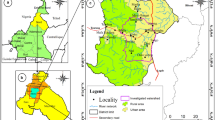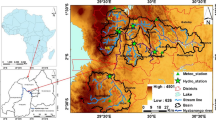Abstract
Surficial soil development was studied in four wetland basins created on the floodplain of the Des Plaines River near Chicago, Illinois, USA. These studies determined changes in the spatial distribution of plant-available nutrients as a result of establishing two different wetland hydrologic regimes. Three wetland basins had mineral soils and one an organic soil. A geostatistical analysis including kriging of collected data indicated that all soil parameters showed significant changes in their spatial structure as a result of the water inputs and unidirectional flows. The degree of spatial variability as indicated by autocorrelation in the soil data (i.e., points closer to one another are more similar than points further apart due to the influence of landscape processes) declined for all parameters except Mg+2. Temporal changes in the spatial patterns of extractable phosphorus (P) and percent organic carbon (OC) tended to be inverse; P declined in areas where OC increased and vice versa. The spatial pattern of these changes was dissimilar in the mineral soils as compared to the organic soil and was related to patterns of primary productivity. Zones of P uptake and OC accumulation were also related to wetland hydrology and primary productivity. Changes in the distribution of nutrients, particularly P, may be viewed as a result of nutrient spirals within the wetlands. By comparison, the reorganization in the concentrations of K+ and Ca+2 appear to have been mediated by cation exchange processes. The formation of new concentration gradients was strongly related to both flow pathways and the different water inflow rates. The formation of concentration gradients in exchangeable cations was not reflected in the average concentrations within each basin. Mean values changed significantly in only a few instances. Reducing data in this way missed important biogeochemical changes occurring within the experimental wetland basins.
Similar content being viewed by others
References
Allison, L.E., Bollen, W.B. and Moodie, C.D. 1965. Total carbon. In: Black, C.A. (ed.), Methods of Soil Analysis Part II. Chemical and Microbiological Properties. pp. 1346-1366. American Society Agriculture, Inc., Madison, WI.
Barko J.W. and Smart, R.M. 1981. Sediment-based nutrition of submerged macrophytes. Aquatic Botany 10: 229–238.
Barko J.W. and Smart, R.M. 1983. Effects of organic matter additions to sediment on the growth of aquatic plants. Journal of Ecology 71: 161–175.
Burgess, T.M. and Webster, R. 1980. Optimal interpolation and mapping of soil properties. II. Block kriging. Journal of Soil Science 31: 333–341.
Burrough, P.A. 1983. Multiscale sources of spatial variation in soil. 1. The application of fractal concepts to nested levels of soil variation. Journal of Soil Science 34: 577–597.
Cronk, J.K. and Mitsch, W.J. 1994. Aquatic metabolism in four newly constructed freshwater wetlands with different hydrologic inputs. Ecological Engineering 3: 449–468.
Dolan, T.J., Bayley, S. Zoltek, J. and Hermann, A. 1981. Phosphorus dynamics of a Florida freshwater marsh receiving treated wastewater. Journal of Applied Ecology 18: 205–219.
Fennessy, M. S., Cronk, J.K. and Mitsch, W.J. 1994. Macrophyte productivity and community development in created freshwater wetlands under experimental hydrological conditions. Ecological Engineering 3: 469–484.
Gambrell, R.P. and Patrick, W.H. Jr. 1978. Chemical and microbiological properties of anaerobic soils and sediments. In: Hook, D.D. and Crawford, R.M. (eds.), Plant Life in Anaerobic Environments. Ann Arbor Science Publishers, Ann Arbor, MI.
Grace, J.B. 1988. The effects of nutrient additions on mixtures of Typha latifolia L. and Typha domingensis Pers. along a water depth gradient. Aquatic Botany 31: 83–92.
Hey, D.L., Barrett, K.R. and Biegen, C. 1994. The hydrology of four experimental constructed marshes. Ecological Engineering 3: 319–343.
Hossner L.R. and Baker, W.H. 1988. Phosphorus transformations in flooded soils. In: Hook, D.D. et al. (eds.), The Ecology and Management of Wetlands. Volume 1: Ecology of Wetlands. pp. 293-306. Timber Press, Portland, OR.
Howard-Williams, C. 1985. Cycling and retention of nitrogen and phosphorus in wetlands: a theoretical and applied perspective. Freshwater Biology 15: 391–431.
Johnston, C.A., Pinay, G. Arens, C. and Naiman, R.J. 1995. Influence of soil properties on the biogeochemistry of a beaver meadow hydrosequence. Soil Science Society of America Journal 59: 1789–1799.
Klopatek, J.M. 1978. Nutrient dynamics of freshwater riverine marshes and the role of emergent macrophytes. In: Good, R.E., Whigham, D. and Simpson, R.L. (eds.), Freshwater Wetlands: Ecological processes and management potential. pp. 196-216. Academic Press, New York.
Lyon, J.G., Drobney, R.D. and Olsen, C.E. Jr. 1986. Effects of Lake Michigan water levels on wetland soil chemistry and distribution of plants in the straits of Mackinac. Journal of Great Lakes Research 12: 175–183.
Mitsch, W.J. 1989. Wetlands of Ohio's Coastal Lake Erie: A Hierarchy of systems. Final Report BS-007, Ohio Sea Grant Program, Columbus.
Mitsch, W.J. and Gosselink, J.G. 1993. Wetlands, 2nd ed. Van Nostrand Reinhold. New York.
Mitsch, W.J., Cronk, J.K., Wu, X. Nairn, R.W. and Hey, D.L. 1995. Phosphorus retention in constructed freshwater riparian marshes. Ecological Applications 5: 830–845.
Newbold, J.D., Elwood, J.E., O'Neill, R.V. and Sheldon, A.L. 1983. Phosphorus dynamics in a woodland stream ecosystem: a study of nutrient spiraling. Ecology 64: 1249–1265.
Ponnamperuma, F.N. 1972. The chemistry of submerged soils. Advances in Agronomy 24: 29–96.
Ponnamperuma, F.N. 1984. Effects of flooding on soils. In: Kozlowski, T.T. (ed.), Flooding and Plant Growth, pp. 9-45. Academic Press Publishers, New York.
Robertson, G.P. 1987. Geostatistics in ecology: interpolating with known variance. Ecology 68: 744–748.
Sanville, W. and Mitsch, W.J (eds.). 1994. Creating freshwater marshes in a riparian landscape: research at the Des Plaines River Wetlands Demonstration Project. Ecological Engineering 3: 315–317.
SAS Institute. 1987. SAS user's guide: statistics. SAS Institute, Cary, North Carolina, USA.
Tabor, J.A., Warrick, A.W., Pennington, D.A. and Myers, D.E. 1984. Spatial variability of nitrate in irrigated cotton: I. Petioles. Soil Science Society of America Journal 48: 602–607.
Trangmar. B.B, Yost, S. and Uehara, G. 1985. Application of geostatistics to spatial studies of soil properties. In: Brady, N.C. (ed.), Advances in Agronomy, pp. 45-95. Academic Press Publishers, New York.
Urban, D.T. 1990. Methods of determining residence time distribution in a reconstructed wetland. Masters Thesis, Illinois Institute of Technology. Chicago, Il. 76 pp.
Viera, S. R., Hatfiled, J.L., Nielsen, D.R. and Biggar, J.W. 1983. Geostatistical theory and application to variability of some agronomical properties. Hilgardia 51: 1–75.
Author information
Authors and Affiliations
Rights and permissions
About this article
Cite this article
Fennessy, M.S., Mitsch, W.J. Effects of hydrology on spatial patterns of soil development in created riparian wetlands. Wetlands Ecology and Management 9, 103–120 (2001). https://doi.org/10.1023/A:1011104902410
Issue Date:
DOI: https://doi.org/10.1023/A:1011104902410




